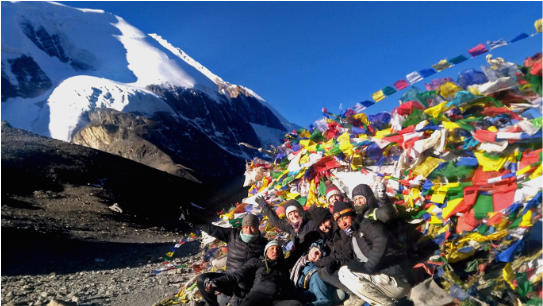The Annapurna Circuit Trek is one of the most iconic trekking adventures in the world, offering a complete Himalayan experience. This legendary route encircles the Annapurna Massif, crossing diverse landscapes, cultural terrains, and the formidable Thorong La Pass (5,416 m). With its blend of natural beauty, cultural richness, and adventure, the Annapurna Circuit Trek continues to attract trekkers seeking a truly transformative journey.
Highlights of the Annapurna Circuit Trek
1. Diverse Landscapes
The trek takes you through a variety of landscapes, from lush subtropical forests and terraced fields to alpine meadows and barren high-altitude deserts. Each step reveals a new facet of Nepal’s topography, creating a dynamic trekking experience.
2. Thorong La Pass
The Thorong La Pass is the highest point of the trek and a major highlight. At 5,416 meters, crossing the pass is a test of endurance and determination, rewarding trekkers with sweeping views of the Annapurna and Dhaulagiri ranges.
3. Rich Cultural Heritage
The trek traverses villages inhabited by diverse ethnic groups, including Gurungs, Thakalis, and Manangis. These communities offer an authentic glimpse into Himalayan culture, with opportunities to visit Buddhist monasteries, witness traditional practices, and savor local cuisines.
4. Muktinath Temple
A spiritual highlight of the trek, Muktinath is a sacred site for both Hindus and Buddhists. Located at 3,800 meters, the temple is surrounded by 108 water spouts and a perpetual flame, symbolizing purification and enlightenment.
5. Kali Gandaki Gorge
The trek takes you through the Kali Gandaki Gorge, one of the deepest gorges in the world. Flanked by the Annapurna and Dhaulagiri ranges, this section offers dramatic landscapes and geological marvels.
Standard Itinerary and Challenges
The Annapurna Circuit Trek typically takes 15 to 20 days, depending on the chosen route and acclimatization days. A standard itinerary includes:
- Kathmandu to Besi Sahar: The journey begins with a drive to Besi Sahar, the gateway to the Annapurna Circuit.
- Trek Through Villages: The trail passes through villages like Chame, Pisang, and Manang, where trekkers acclimatize and explore the local culture.
- Crossing Thorong La Pass: The trek’s pinnacle involves an early morning ascent to Thorong La Pass, followed by a descent to Muktinath.
- Descent to Jomsom: The route descends through Kagbeni and Marpha before concluding in Jomsom, from where trekkers return to Pokhara.
Challenges:
- Altitude Sickness: The trek reaches significant elevations, especially at Thorong La Pass. Proper acclimatization and hydration are essential to prevent Acute Mountain Sickness (AMS).
- Physical Demands: The trail includes long walking days, steep ascents, and challenging descents, requiring good fitness and mental resilience.
- Weather Conditions: Sudden weather changes in the Himalayas can pose challenges, particularly near the pass.
Despite these hurdles, the rewards of the trek far outweigh the difficulties, making it a bucket-list adventure for many.
Best Time for the Annapurna Circuit Trek
The trek is best undertaken during two primary seasons:
- Spring (March to May): During this season, the trail is adorned with blooming rhododendrons, and the weather is generally stable, offering clear views of the mountains.
- Autumn (September to November): Known for its crisp air and excellent visibility, autumn is the most popular season for the Annapurna Circuit Trek.
While winter (December to February) and monsoon (June to August) treks are possible, they come with added challenges like extreme cold, snow-covered trails, or slippery paths.
Preparation Tips for the Annapurna Circuit Trek
- Build Fitness: Regular cardio, strength training, and trekking practice can help prepare for the physical demands of the trek.
- Pack Essentials: Bring warm clothing, a high-quality sleeping bag, trekking poles, sturdy boots, and a reliable backpack.
- Permits: Obtain the necessary permits, including the Annapurna Conservation Area Permit (ACAP) and Trekkers’ Information Management System (TIMS) card.
- Guides and Porters: Hiring a guide or porter ensures safety and enriches the experience with cultural and geographical insights.
- Hydration and Acclimatization: Staying hydrated and scheduling acclimatization days can mitigate the risks of altitude sickness.
Unique Features of the Annapurna Circuit Trek
The Annapurna Circuit Trek stands out for its accessibility and variety. Unlike single-destination treks, it offers a circular route that covers diverse ecosystems and cultures. The availability of teahouse accommodations ensures a comfortable trekking experience, even in remote areas. Additionally, the trail is well-marked, making it suitable for both solo trekkers and guided groups.
Conclusion
The Annapurna Circuit Trek is more than just a trek—it is a journey through the heart of the Himalayas that combines natural beauty, cultural immersion, and personal accomplishment. From crossing the awe-inspiring Thorong La Pass to exploring the spiritual charm of Muktinath, every step of this trek is a reminder of Nepal’s unparalleled allure.
While the trek demands physical fitness and mental fortitude, its rewards are immeasurable. For adventurers seeking a blend of challenge, diversity, and cultural depth, the Annapurna Circuit Trek promises an experience of a lifetime. Whether you’re a seasoned trekker or a first-time adventurer, this journey will leave you with memories that resonate long after the trail ends.

